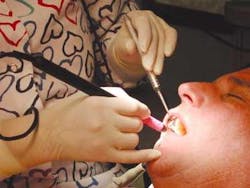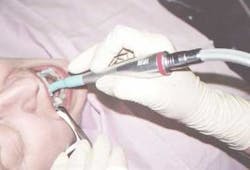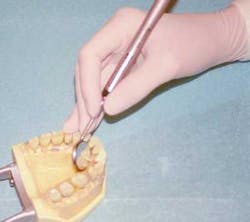Glove solutions
One size, style, and color does not fit all when it comes to your gloves
By Anne Nugent Guignon, RDH, MPH
Since we do not live in a "one-size-fits-all" world, a number of different things should be considered when selecting gloves. The list should include comfort and fit, durability, ability to withstand chemical exposure, length of procedure time, and whether the glove is designed for the task.
null
null
While no one would deny the importance of infection-control procedures, have you ever considered that the gloves we wear may actually be a significant contributor to the rising number of workplace-related injuries suffered by dental healthcare workers?
Think about how ridiculous it would be if we all tried to wear the same size of shoes. Imagine trying to force your feet into a pair of shoes one size too small. Within minutes, you'd be limping around with aching toes and sore feet begging to be released from bondage. On the other end of the spectrum, imagine navigating in shoes several sizes too big. You'd spend all of your time stumbling around and trying to avoid falling all over yourself. If all you had ever worn were Keds, what do you think would happen if a 4-inch pair of backless spike heels was suddenly your only choice of footwear? Certainly these images sound completely implausible, but wearing improperly fitted gloves is just as silly. Gloves are meant to protect us, not annoy us.
Since there are nearly 300 different brands of medical-grade gloves classified as appropriate for use in treating dental patients, how do you go about the task of selecting the right glove for each clinician and each task? First, there is no standardization in glove sizes. One company's brand of "small" may have an entirely different fit than another manufacturer's version of a small glove, regardless of the size designated on the box or in the catalogue. With a little detective work, most clinicians can find a glove that fits their hands comfortably.
null
Finger length can vary as dramatically between glove brands as it does in people. Imagine how uncomfortable it would be to wear a pair of socks that were either too long or too short for your feet. In addition to finger length, it is important to consider how the glove fits the palm of the hand and the wrist. Select gloves that are not too tight across the palm or bind in the wrist area. As inconsequential as it may seem, day in and day out compression of the soft tissue can irritate and damage muscles, nerves, and tendons. Wearing a glove that constricts hand and wrist tissues is considered to be a significant risk factor in the development of a wide variety of hand and wrist cumulative trauma disorders.
Females are more likely to exhibit a higher risk for carpal tunnel syndrome due to the confounding effects of pregnancy, oral contraceptives, and edema which each cause the carpal tunnel area in the wrist to become narrower, placing additional stress on delicate nerves and tendons. Therefore, the importance of gloves that fit properly in the wrist area becomes more important than ever.
null
null
Two styles of disposable gloves are made for dental procedures — ambidextrous and hand-specific. Ambidextrous gloves can be worn on either hand. These gloves are designed with the thumb in the same plane as the other fingers, which is contrary to the position of the thumb when the hand is a neutral posture. Meanwhile, hand-specific gloves place the thumb in a natural position, which reduces unnecessary strain on the thumb. Hand-specific gloves, also known as right and left gloves, come in sizes just like a pair of high-quality leather gloves that you would purchase for wintertime. For example, the clinician who wears a small glove might have to try several different sizes of hand-specific gloves to determine which one offered the most comfortable fit. The cost of hand-specific gloves is higher but, considering that none of us can do our job well with aching hands, it is a small price to pay for comfort and to lessen the chance of developing a repetitive strain injury. Some clinicians choose to wear ambidextrous gloves for short tasks and hand-specific gloves for longer, more intricate procedures.
Natural rubber latex can provide clinicians with the most precise glove fit due to its elastic properties, but many clinicians are selecting synthetic alternatives as a personal choice or in order to satisfy the requirements of a latex-free environment. Vinyl gloves are the original alternative to latex gloves. These gloves are made from PVC and are inexpensive. However, due to the limitations of the material, the fit is often less than ideal, subjecting wearers to potential hand fatigue if worn for extended periods of time. According to research conducted by one major glove manufacturer, vinyl begins to breakdown during use, resulting in microscopic tears and cracks in the gloves. This material failure eliminates the barrier protection of gloves, leaving clinicians unprotected to bloodborne pathogens. In light of these findings, the number of uses for vinyl gloves in today's dental practices should be very limited, if used at all.
Fortunately there are other non-latex choices available to dental professionals — chloroprene and nitrile. Chloroprene gloves traditionally offered a more precise and more elastic fit than nitrile. Nitrile, on the other hand, offered a higher degree of puncture resistance. However, they were generally thicker and had a limited ability to stretch and conform to a clinician's hand. Even though nitrile offered the best barrier protection, a clinician's tactile sensitivity was reduced with this type of glove.
Within the last few years, a polymer chemist at a major glove manufacturer was intrigued with developing a nitrile glove that would stretch and feel like latex. His breakthrough research has led to a nitrile glove that stretches more with use without losing its shape. This new nitrile formulation also gives the wearer a sense of tactile sensitivity that makes the glove feel much thinner than other nitrile gloves available in today's market. It is evident that, in the future, the perfect-fitting glove will most likely be made of a synthetic material that will far surpass our traditional natural rubber latex gloves.
Now that we have looked at the issues of size, fit, and fabric, let's consider all of the other possibilities in glove selection. Two decades ago, all gloves were some shade of white and all had smooth surfaces. Now, just like all other segments of the market, we now have choices.
While gloves that are smooth to the touch are the norm, they are a serious ergonomic nightmare to the dental clinician. We work in wet environments, and gloves with texture offer traction. Traction reduces our pinch grip and lessens the risk of hand fatigue.
There is no standardization regarding glove texture, meaning the amount and type of texture can vary dramatically from one manufacturer to another. Gloves are available with texture on the entire gripping surface or just limited to the fingertips. If textured gloves interest you, it is important to evaluate products from a number of manufacturers. However, clinicians wearing textured gloves report an overwhelming preference for practicing with a textured glove. Remember, we are very fine-tuned to subtle differences in tactile sensitivity, so if you become accustomed to the texture that one glove offers, you may not be able to adapt to another product easily.
Color and fragrance are some additional considerations in selecting the appropriate glove. I invite you to pick up a latex glove and smell it. Most of them suffer from an entirely disgusting odor I affectionately refer to as "eau de latex." It stinks. This dreadful smell conjures up all of our patients' worst-imaginable dental stories and then takes them to the 10th power. Now imagine if you don a glove that has a light peppermint fragrance, or smells like grape Kool-Aid or some other non-dental aroma. Do you think your phobic patient is as likely to assume a position in the dental chair that is akin to rigor mortis? For those of you who are traditionalists, just consider the possibilities.
Some gloves are now available with aloe vera and vitamin E. While there is no research to support whether these substances improve comfort, anecdotal reports have been favorable.
Gloves are also available with and without powder. Powdered gloves are easier to put on and the powder functions to absorb moisture, which is especially helpful for those clinicians that perspire easily. While the powder can keep your hands feeling dryer, it does contribute to overall dry skin. Some clinicians combat this dryness with hand creams or lotions, but it is important to note that any petroleum-based product can compromise the integrity of a latex glove. Also many clinicians that report latex sensitivity are actually experiencing a powder-based contact dermatitis, which is easily remedied by using powder-free gloves.
And where is it written that a proper glove is always white or, at best, cream-colored? This reminds me of the shades of a wedding dress or fine bone china. Gloves are meant to be functional, but functional does not mean that they can't be fun. Gloves are available in nearly any shade of the rainbow, meaning you could have a different color for every day of the week or you could choose to color-coordinate your gloves with the color of your scrubs. Imagine the comments patients will make when you don a pair of flamingo pink gloves that just happen to match your uniform of the day!
Some practices purchase gloves based on price alone, while others order only one or two sizes regardless of the hand sizes of those who will wear them. Gloves that are selected based on the initial cost, or in an effort to reduce the variety of gloves within a practice's inventory, can result in a perceived short-term savings. However, there is a false economy in this type of decision. Gloves that lack durability must be replaced much more frequently during procedures, therefore negating any perceived savings. Also, the risk of wearing a poorly fitted glove should be a real concern to all practitioners since improperly fitting gloves result in unnecessary hand fatigue and make it more difficult to perform precise dental procedures, as well as placing practitioners at increased risk for CTDs.
Twenty years ago, there were very few choices in the glove world, but that was before most understood the importance of barrier protection. Now that we understand that, I think it's great that we can have great fit and fashion with great function!
Anne Nugent Guignon, RDH, MPH, practices clinical dental hygiene in Houston, Texas. She writes, speaks, and presents continuing-education courses on ergonomics and advanced ultrasonic instrumentation through her company, ErgoSonics (www.ergosonics.com). She can be reached by phone at (713) 974-4540 or by e-mail at [email protected].
BIOLASE gets FDA approval for Waterlase® usage in apicoectomy surgery
BIOLASE Technology, Inc., a medical technology company focused on pain-free medical and dental procedures, today announced that it has received clearance from the Food and Drug Administration for the patented Waterlase® system for use in apicoectomy surgery. Apicoectomy surgery, a treatment for root canal infections and complications, includes cutting gum flaps, bone and the apex of the tooth to access the infected area. For more information on apicoectomy surgery, go to www.biolase.com.
"Use of the Waterlase for apicoectomies is a very significant development in dentistry. Benefits while performing the procedure with the Waterlase, compared to traditional methods, include less bleeding, less trauma, more precision, smoother cuts, more control and superior visibility," said Malcolm Zola, DDS, chief, oral surgery and maxillofacial surgery, St. Barnabas Hospital, New York City. "Post-operative benefits include reducing or eliminating post-operative pain, inflammation and reducing or eliminating the need for post-op pain medications."





